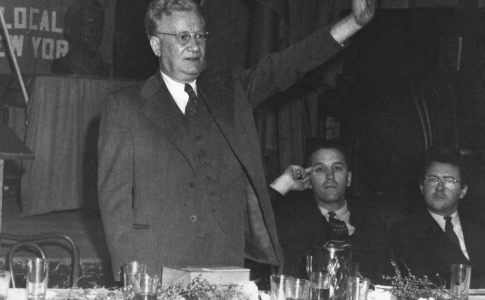Canadian Trotskyism and the Legacy of James P. Cannon

photo James Patrick Cannon, SWP (Socialist Workers Party) local New York
Revolutionary socialists in Canada and the United States began organizing a revolutionary workers’ party around the same time. This occurred in the wake of World War I. The new organizations adopted the name Communist Party, in solidarity with the leading force in the Russian Revolution and in support of the leaders of the world’s first workers’ state, the Soviet Union. In Canada many members of the new party came from the Socialist Party of Canada and from the Social Democratic Party of Canada. In the United States, many of them came out of the Socialist Party of Eugene Debs and from the syndicalist Industrial Workers of the World, like James P. Cannon, who was a Wobbly before he became a Bolshevik. There were many internal tendencies and factions inside the new CPs, until Moscow stamped out internal democracy and required affiliates to the Comintern to expel all opponents of Joseph Stalin. In the USSR, many of Stalin’s political opponents were not just expelled or exiled; they were murdered. Historians say that Stalin killed more Communists than Adolf Hitler did.
Founding leaders of the Communist Party of Canada were Jack MacDonald and Maurice Spector. They worked closely with the leaders of the CP USA, like James P. Cannon and William Z. Foster. Spector and Cannon were delegates to the Sixth Congress of the Communist International in Moscow in 1928.
Spector accidentally got hold of a copy of Trotsky’s “Critique of the Draft Programme of the Communist International,” which criticized the position of Nikolai Bukharin and Joseph Stalin. It especially exposed the anti-Marxist theory of “socialism in one country.” This critique became a basis of the International Left Opposition. In a truly prophetic statement, Trotsky warned that if the Communist International adopted socialism in one country, it would inevitably lead to the nationalist and reformist degeneration of every Communist Party in the world. His prediction—which was ridiculed by the Stalinists at the time—was proved correct. Cannon reported what happened on that fateful occasion:
Through some slip-up in the apparatus in Moscow, which was supposed to be airtight, this document of Trotsky came into the translating room of the Comintern. It fell into the hopper, where they had a dozen or more translators and stenographers with nothing else to do. They picked up Trotsky’s document, translated it and distributed it to the heads of the delegations and the members of the program commission. So, lo and behold, it was laid in my lap, translated into English! Maurice Spector, a delegate from the Canadian party, and in somewhat the same frame of mind as myself, was also on the program commission and he got a copy. We let the caucus meetings and the Congress sessions go to the devil while we read and studied this document. Then I knew what I had to do, and so did he. Our doubts had been resolved. It was as clear as daylight that Marxist truth was on the side of Trotsky. We had a compact there and then—Spector and I—that we would come back home and begin a struggle under the banner of Trotskyism. (1)
No comments:
Post a Comment